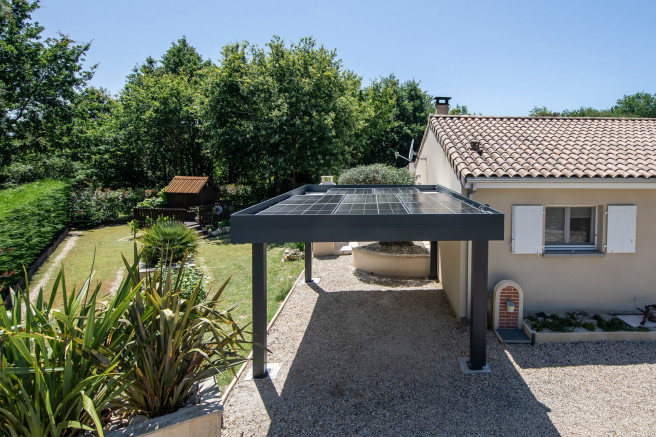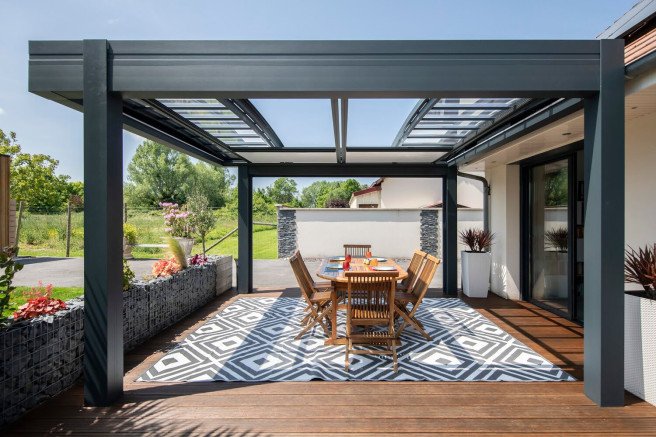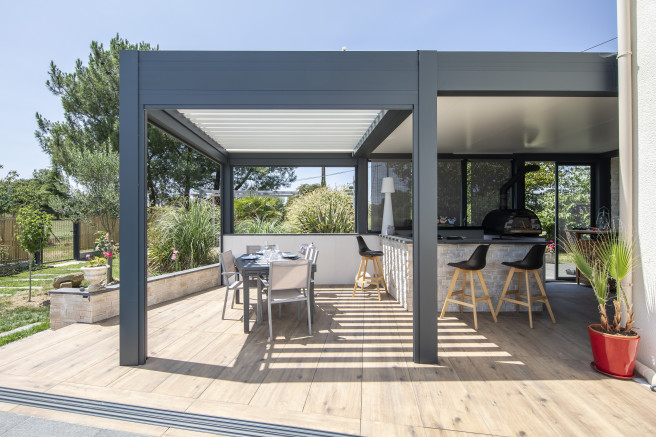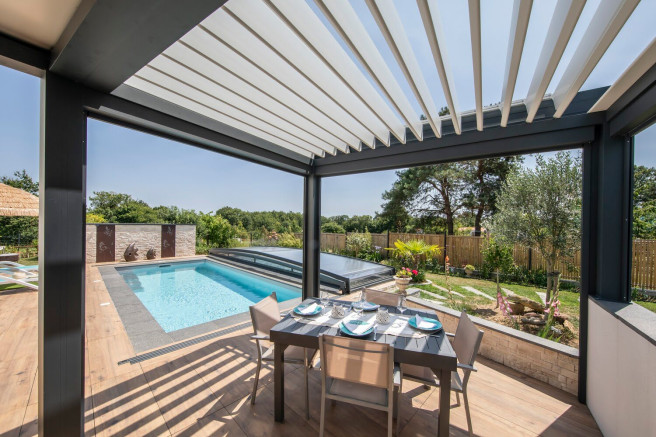Pergola purchasing guide
Welcome to this pergola purchasing guide where you'll find everything you need to know if you choose to install a pergola at home. This outdoor structure is a great way of adding an extra space around your home for living in. It can be used to cover your terrace, be set up in your garden or by your pool. What models are available on the market? What materials can be used? Here we give you the answers to all your questions to help you choose your pergola.
Pergola benefits
Pergolas are mounted on posts that form a supporting structure for a roof or awning. They're really interesting outdoor installations that come with a host of benefits.
First of all, a pergola is an enclosure for your garden or terrace that lets you make the most of your space. It provides you with shade whenever there's strong sunshine. And, if ever it rains, you can still stay outside as you'll be protected and won't ever get wet.
By installing a pergola, you'll also be creating a new space for living. You can add a blind, garden furniture, lighting, plants, etc. And, if you add an auxiliary heater, you can even use your pergola all year round. Like this, you'll be able to enjoy your outdoors any time.
The great advantage of pergolas is that they don't require much work to be set up. You can install the structure quickly in your outdoor setting and if ever there are any formalities to carry out, they're generally really straightforward.
Criteria to take into account before purchasing a pergola
To make sure you choose the right pergola or arbour, you'll need to ask yourself the right questions. Before taking a look at all the features possible for this type of outdoor installation, let's check over a few things. What do you need to think about to make sure you're making the right choice?
Where you wish to install it and its size
The first factor to consider is the place you'd like to install your pergola, as this will impact its shape and size.
This will also make it easier to choose the material and the type of pergola that will be best tailored to your needs. The size you want is also important as it will influence your overall budget for your installation. The amount of sunshine and wind you generally have in your region can also prompt you to choose one model over another.
Its look and your use
To choose your pergola well, you'll also have to know how you wish to use it in your everyday life. For example, if you wish to install garden lounge furniture in your pergola or plants, you'll need to have enough space. You'll also need to be sure of the periods of the year that you intend to use your pergola. All these details will help you choose between a bioclimatic pergola and a fixed-roof one for example.
Also think about the sort of look you'd like to give your home. Feel free to compare the results various materials can offer to find the types of style that will suit you best, but don't forget to think about their other benefits, such as less looking after and resistance too.
Lean-to or free-standing pergola?
There are many different types of pergola, each with its own advantages and disadvantages. The differences between pergolas are to be found in the material used, but above all in the roof. Some pergolas are fixed, others can be opened, and still others have adjustable slats or a canvas roof. Choosing a pergola starts with deciding what kind of structure you want for your home.
Irrespective of whether you go for a bioclimatic, solar-powered, fixed-roof or open-up roof pergola, they can all be installed as a lean-to against a wall of your home or can be free-standing and set up anywhere you wish in your outdoor space.
A lean-to pergola against a wall means you'll be extending your home by adding a covered area that blends indoors and outdoors. This space is an alternative to a veranda and it's much easier to build. A veranda is a real room that requires, above all, insulation work, whereas a pergola is an outdoor enclosure.
If you can't make up your mind between a pergola and a veranda, a good solution could be to add solar panels to the sides of the pergola to have a space that's a little less open to the outside world.
A free-standing pergola can be installed on your house terrace or beside your pool or anywhere in your garden. This enclosure features four posts and a roof under which you can install garden furniture and/or sun loungers.
All lean-to and free-standing pergolas protect you from bad weather, such as rain, and can be used to create shade.
Choosing between a lean-to and a free-standing pergola depends on your needs, expectations and desires, as well as the configuration of your home and your outdoor space. A lean-to structure has the advantage of being directly accessible from your home, but a free-standing pergola will better set off another part of your property, such as your garden.
Materials used for pergolas: wood, PVC, aluminium, etc.
The choice of material used for manufacturing a pergola will impact your budget, the style of the pergola as well as its resistance. As such, this is an important factor to keep in mind when choosing your pergola.
First of all, you can choose to have a wooden pergola structure. Wood has the advantage of being resistant and natural. It's material that's not necessarily all that expensive, but it requires some looking after. You may need to renew the wood stain regularly to increase its service life and to prevent insects from proliferating in the wood.
An aluminium structure is often chosen for pergolas. It boasts up-to-the-minute design and is highly-resistant. A pergola with an aluminium structure will last for years and will need very little looking after. This solution is often more expensive, but is well worth the money. It's also the best material if you opt for a bioclimatic pergola or one with an open-up roof.
Wrought iron can also be used to make a pergola. It's often chosen for its romantic, vintage look. However, wrought iron won't give you as much freedom as an aluminium or wooden structure.
Last but not least, the final material you can choose for your pergola is PVC. It's cheaper than aluminium, looks very much like it and is ever-so easy to look after. However, it's less resistant over time.
How should you look after your pergola?
The choice of material used to build a pergola will influence the budget, aesthetics and durability of the installation. So it's an important step when choosing your pergola.
First of all, the pergola structure can be made of wood. Wood has the advantage of being hard-wearing and natural. It's not necessarily an expensive material, but it does require a little care. You may need to treat it regularly to extend its life and prevent insects from proliferating in the wood.
Aluminium structures are often the preferred choice for pergolas. It offers a modern design, while being extremely hard-wearing. The structure of an aluminium pergola will last for years, while requiring minimal maintenance. This solution is often more expensive, but well worth the investment. It is also the most suitable material for installing a bioclimatic pergola or one with an opening roof.
Wrought iron can also be used in the design of a pergola. It is often chosen for its romantic, retro design. However, wrought iron does not offer as much freedom as an aluminium or wooden structure.
The last option for the structure of your pergola is PVC. This is a less expensive solution than aluminium, with a similar appearance and easy maintenance. It is, however, less durable over time.
How much does a pergola cost?
The maintenance of a pergola depends entirely on the materials used for its structure. As we have seen, wood will need regular treatment. Wrought iron may also require anti-rust treatment.
For PVC and aluminium, there are no special products to use. A simple wipe down with soapy water and a sponge will suffice from time to time to remove the dust.
The bioclimatic pergola will need special care when it comes to maintenance: try to regularly remove any leaves that might get caught between the slats and prevent them from working properly. When cleaning, also avoid using a powerful jet, to avoid damaging them.
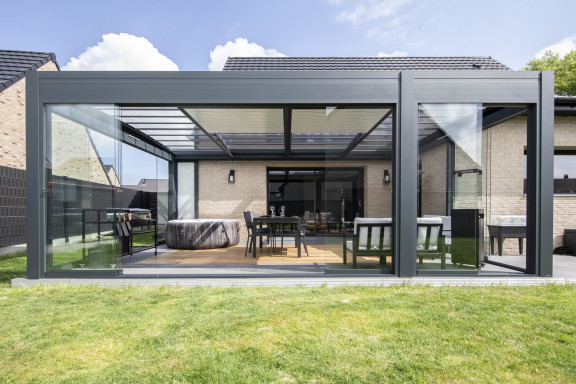
How much does a pergola cost?
The price of pergolas is inevitably a question that arises when you want to build one. The size, shape, materials, type of roof and additional features, such as motorisation, all play a part in the budget.
Wood and PVC will cost less, but an aluminium structure is really ideal for an attractive, hard-wearing installation. For an aluminium product, you can expect prices of around €7,000 for fixed or opening roofs and €8,000 for pergolas with adjustable slats.
To get a better idea and precise information for your project, the best thing to do is ask a pergola professional for a detailed quote. He or she will be able to tell you more about your options, how to install it and which materials to choose.
What are the formalities for installing a pergola?
The good news is that the administrative formalities for pergolas don't have to be complicated.
You don't need to take any particular steps for pergolas measuring less than 5 m².
Pergolas with a surface area of between 5 m² and 20 m² only require a preliminary works declaration.
Finally, only pergolas larger than 20 m² require planning permission.
This information may change if you are in a protected area. In any case, check the Local Planning Scheme (PLU) to see if there are any restrictions on the material or dimensions authorised for pergolas.
To choose your pergola, you need to start by studying your needs and expectations, to find the best model. In any case, a pergola has more than one advantage. It will provide pleasant shade in the height of summer, and the awning will also act as protection against the rain, so you can make the most of your terrace, garden or swimming pool. Use this pergola buying guide, and our other articles, to start thinking about a list of your criteria, before contacting a professional for an initial quote.
